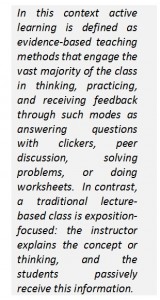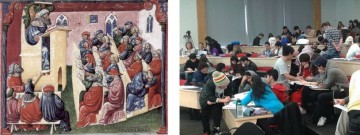Many educational institutions are working towards incorporating more active learning and less traditional, lecture-based teaching methods in STEM (Science Technology Engineering and Math) classrooms. Some may wonder “is active learning really better than lecturing?”  Yes! Research in science education clearly indicates that active learning is better.
Yes! Research in science education clearly indicates that active learning is better.
Continue reading to find out more.
Traditional Lecturing (left, image from Wikimedia) and Active Learning (right, image from EOAS CWSEI)
In this post we review an important meta-analysis on active learning in STEM published this year in PNAS, which concludes that when compared to lecture-based teaching, active learning is far more effective at promoting learning as measured by increased performance on exams, and reducing failure rates. A short summary and commentary of the paper by Dr. Carl Wieman can be found here. The authors began with 642 published studies from STEM education research, and after applying stringent criteria such as controlling for student equivalence, instructor equivalence, and exam equivalence, they looked at 225 studies to evaluate the effect of active learning on test scores and failure rates compared to lecture-based classes. The differences between lecturing and active learning are compelling:
Active learning improves test scores by half a standard deviation: an effect size of 0.47.
Active learning decreases average failure rates across STEM courses from 34% to 21%.
Freeman and his co-authors put some of these effects into context. For example, an effect size greater than 0.20 in K-12 education literature would be considered a driver for policy change. In the medical field, such a difference between the control and treatment group would make it unethical to deny the control group the treatment. Even more stunning, is the estimation that, by reducing failure rates, active learning in STEM can save students $3.5 million (US) in tuition dollars. We need to question if lecture-based teaching is knowingly disadvantaging a large number of students that have been admitted into the University.
“in undergraduate STEM education, we have the curious situation that, although more effective teaching methods have been overwhelmingly demonstrated, most STEM courses are still taught by lectures—the pedagogical equivalent of bloodletting” (Wieman, 2014)
We suggest that using active learning in our STEM classes will result in:
– More students learning more science (technology, engineering, and math)!
– More scientifically informed citizens leaving our programs
– More people entering STEM careers
So, we no longer need to wonder if active learning really is better than lecturing. It is! If our active learning methods are based on evidence-based best practices, we can safely assume that active learning is better than lecturing. Is this the end of lecturing as the primary mode of teaching? Will active learning become the new “traditional” approach? Do you want to talk more about active learning in your class? Contact us!
More information on evidence-based best practices: Instructor guidance, what all instructors should know, videos about active learning, how people learn, what not to do
What does this mean for education research? There is no longer a need to compare active to traditional, but rather active vs. active. It is now more important to investigate what types of active learning approaches are the most effective to address questions like: What is the best balance between information transfer and active learning in the classroom? How do different active learning approaches impact different types of students?
What are we doing in Biology? Many STEM instructors and post-docs at UBC are (and have been for a long time!) teaching and researching the effectiveness of active learning in their classes. UBC provides an incredible, supportive community and context for science education research and implementing evidence-based active learning practices in classes. Here is a brief summary of some of the research we are doing in UBC Biology as part of the Life Science – Carl Wieman Science Education Initiative:
- Targeted pre-class readings: they do the reading and are prepared for class
- Two-stage review activity (here and here): save class time and make review effective
- Two-stage exams improves student learning: improved retention
- Effects of in-class deliberate practice on written explanations
- Creating effective clicker questions
- Concepts-first, jargon-second improves learning
- Improving student problem solving in genetics
- Factual and conceptual genetics knowledge retention from 1st to 4th year
- The impact of active learning on long-term retention
- Large scale documentation of teaching practices from 1st to 4th year using COPUS (Classroom Observation Protocol for Undergraduate STEM).
References:
Freeman et al. 2014. Active learning increases student performance in science, engineering, and mathematics. PNAS, 111(23).
Wieman, CE. 2014. Large-scale comparison of science teaching methods sends clear message. PNAS, 111(23).
